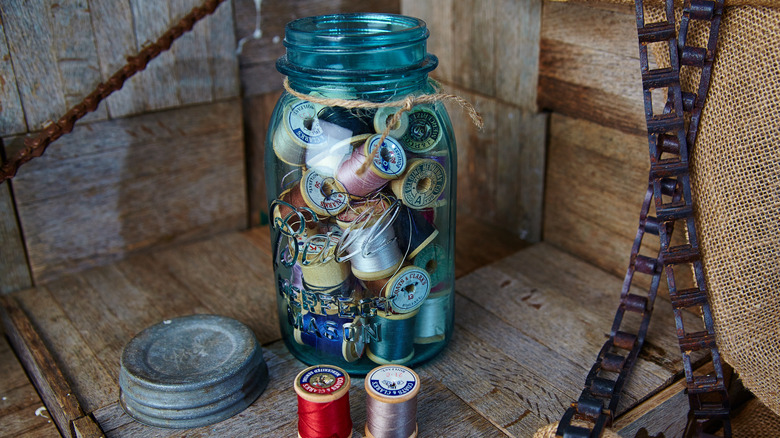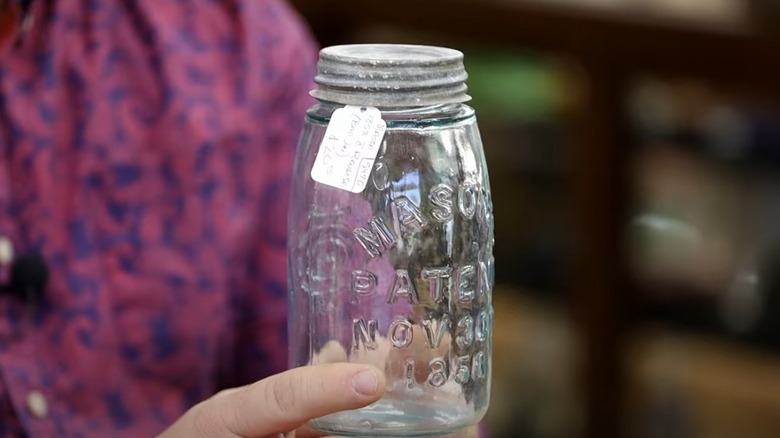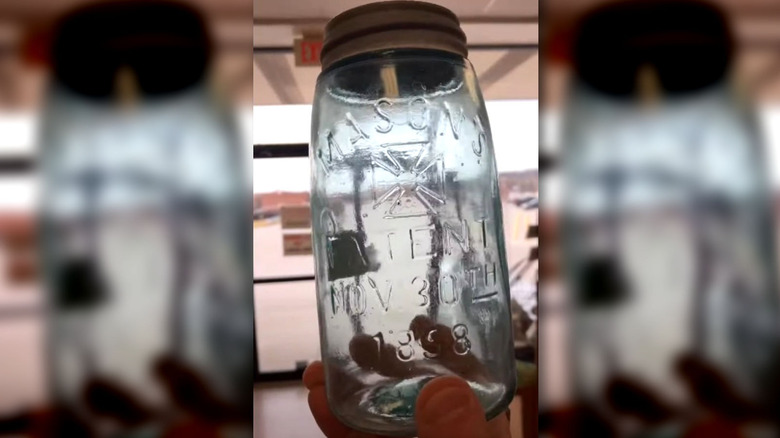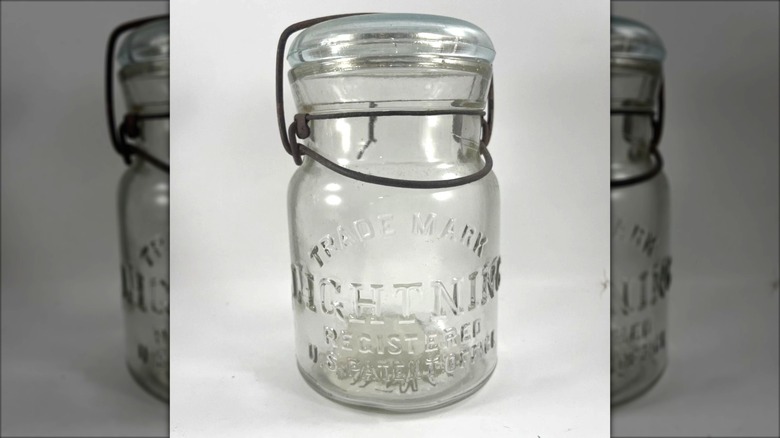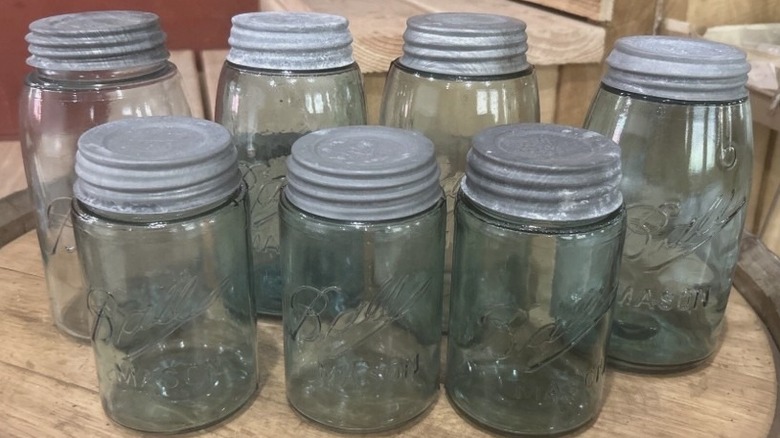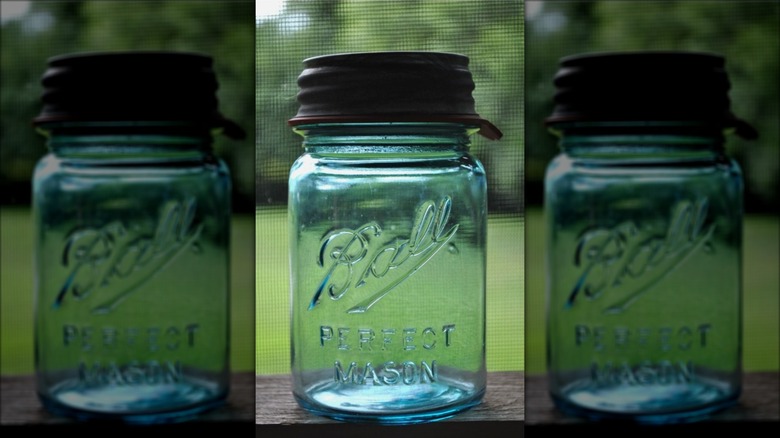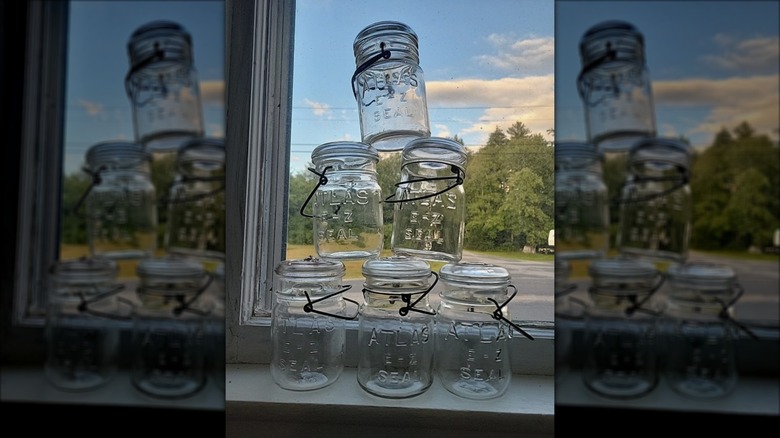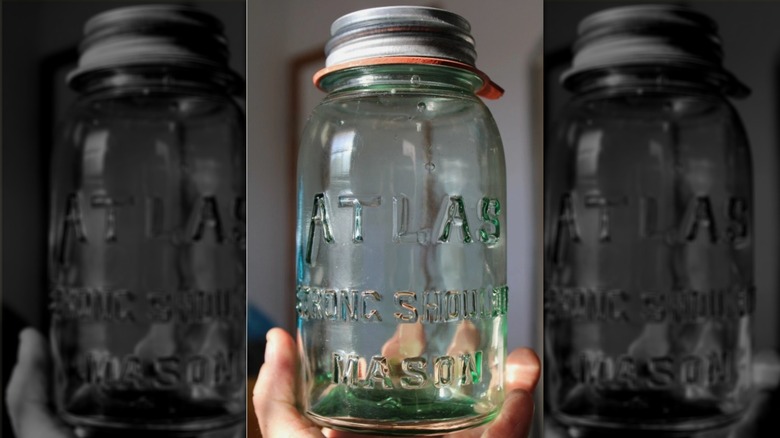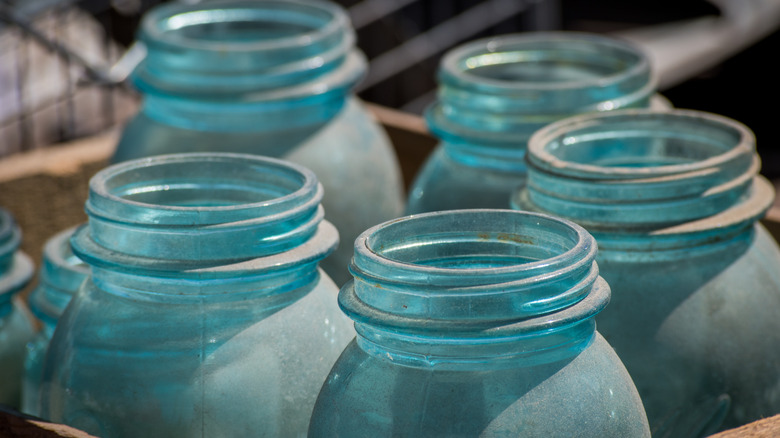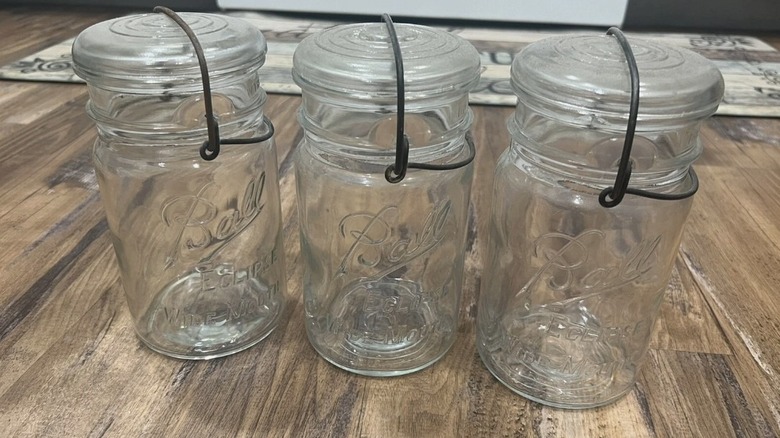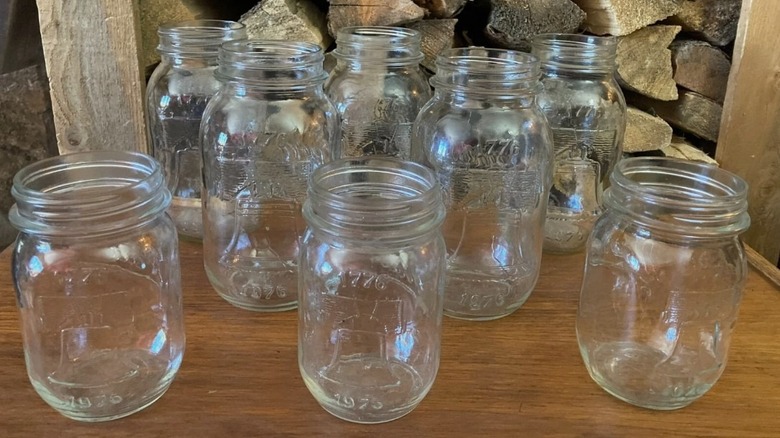The Value Of Vintage Mason Jars By Year: A Guide For Collectors And Thrifters
We may receive a commission on purchases made from links.
Next time you're strolling through the glassware aisle at your local Goodwill, you may want to pay close attention to the Mason jar section. Mason jars aren't just a continually trending home decor item — they are an amazing invention that helped turn-of-the-century homemakers ensure they had a stable way to preserve food for the winter. Invented by John Landis Mason in 1858 and later produced by multiple companies after his patent expired, these jars continue to offer a secure way to store food. Even more interesting than their many uses, vintage and antique Mason jars can bring serious value to savvy thrifters.
Mason jars can vary in value based on many factors — age, rarity, and features like embossing or color. Whether you're a collector seeking a rare find or a thrifter wondering if Mason jars are going out of style as home decor (the answer is most likely no), their nostalgic appeal endures. Knowing important information like the number to look for on Mason jars, patent dates, or brand logos can turn flea market finds into absolute treasures. Values for antique Mason jars can range widely from $5 to several hundred dollars, with a few rare examples worth over $1000 – you just need to know what to look for.
1858 John Landis Mason patented first Mason jar
Authentic early Mason jars can be identified by their ribbed tops with zinc lids and rough lips. Another feature is that the jar's sides flow directly from the lid to the base at a straight angle. These jars were typically made of clear or transparent aqua-marine glass. After his patent expired, other manufacturers made variations of this jar (but still using the patent embossed date). You will also find that these jars will have bubbles or irregularities. If it's in great condition with its lid, a gallon-size jar can sell for a pretty penny, with smaller ones averaging closer to $100.
1886 Hero cross Mason Jar
By 1888, Mason's patent had fully expired, and many manufacturers were using his design, although they did add their brand logos and various identifying marks. One such company, Hero Glass Works/Hero Fruit Jar Company, designed its own version in 1888 that included a Maltese cross on the front of the jar above Mason's patent embossing. These jars come in various colors (including amber) and sizes, and value is always determined by condition, color, and whether it has its original lid. If the embossing is clear, they can sell for upwards of $300 depending on quality.
1880s lightning closure jar
In the 1880s, Henry Putnam's last iteration of the lightning-closure mason jars became popular. They had a more secure closure that included a glass lid, a rubber gasket, and a wire bail. Made with clear or aqua colored glass, rare amber or green versions can be $20 to $200, while common ones sell for about $5 to $30. Thrifters should be able to find these at flea markets or vintage stores. Look for "Lightning" embossed on the face of the jar or "Putnam" on the bottom and intact bails, as rust lowers the value.
1900s Ball triple-L logo debut
One sought-after Mason jar is the Ball triple "L," released between 1900 and 1910, and it's definitely worth keeping an eye out for. The Ball triple "L" gets its name from the extra loop at the end of the Ball script logo. It's also recognizable by what collectors call the "dropped 'a,'" where the letter trails from the capital "B" instead of being attached. When found in excellent condition — with rare colors — they can fetch hundreds of dollars.
1913 Ball Perfect Mason jar
Introduced in 1913, the Ball Perfect Mason jar quickly became an American canning staple. They feature the cursive "Ball" logo above block letters saying "PERFECT MASON" and often appear in the classic aqua "Ball Blue" glass. Common quarts or pints fetch $5 to $30, but scarce mold numbers (11-15), errors like the "dropped a" in "Mason," or rare olive-green hues can sell for $50 to $500 and sometimes even higher. Look for an Owens scar (circular seam) on the base and mold number to confirm authenticity and avoid bubbly reproductions. Collectors prize complete sets for their nostalgic charm.
1920s Atlas E-Z seal jars
Hazel-Atlas introduced the Atlas E-Z Seal jar in the 1920s, featuring a glass lid and wire-bail closure that simplified canning for homemakers. These jars are clear or aqua and sell for $5 to $30, while rare amber or green versions can fetch $20 to $200 depending on the condition. These jars often appear in flea market box lots, but value depends on condition — look for sharp "Atlas E-Z Seal" embossing and rust-free bails. They are a sought-after vintage find among collectors.
1920s to 1940s Atlas Strong Shoulder Mason jars
Atlas Strong Shoulder Mason jars were made from the 1920s through the 1940s, built to be durable for use in home canning. They have a distinctive shape, reinforced shoulders, and their sharp embossed logo. Most of these jars are clear or aqua, but there are rare green or amber versions that are especially prized by collectors. Condition is what determines value — look for crisp embossing, intact lids, and minimal chips. Average jars sell for around $5 to $25.
1933 Mistake upside-down Ball logo jar
From 1900 to 1910, Ball intentionally created an "upside-down" jar to dispense coffee, but in 1933, they had an error jar that accidentally embossed the Ball logo upside down. This upside-down jar and the error appeared on the "Perfect" line. The way to tell if you have the rare 1933 error is by the Ball logo lettering. If your jar has the logo from the 1900s, it is an intentional design and is somewhat valuable, worth a couple of hundred dollars. If your upside-down jar has the 1930s logo, you have an extremely valuable find.
1940s Ball Eclipse Lightning wide-mouth jars
During World War II, many homemakers were encouraged to take up canning to preserve the food from their victory garden. A great example of a popular canning jar is the war period version of the Eclipse wide-mouth jar by Ball. This jar was made from 1926 to 1952 and is a collector's favorite. They are identifiable by their smoother, more refined Ball logo and the signature lightning-style closure. Average jars sell for $10 to $25, while rarer colors or pristine jars with lids intact can go for $30 or more.
1976 Bicentennial commemorative Mason jars
For America's 200th birthday, Ball and Anchor Hocking released Mason jars embossed with the Liberty Bell and "1776-1976". Available in pints and quarts, most were clear or aqua glass, though some appeared in other colors. There were even a few rare milk glass versions of the Ball bicentennial jar made. While some of these jars sell for $5 to $20, rarer and excellent condition jars can go for $50 or more. Keep an eye out for Ball or Anchor Hocking with a patriotic pattern, and you may have just found a collectible.
